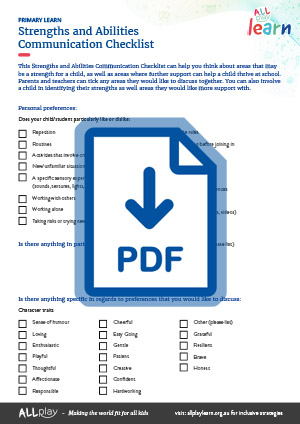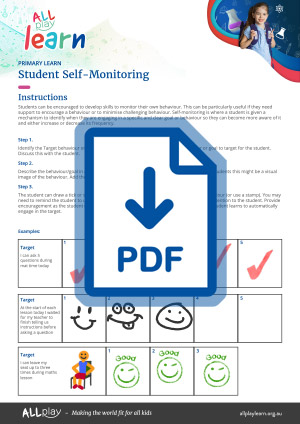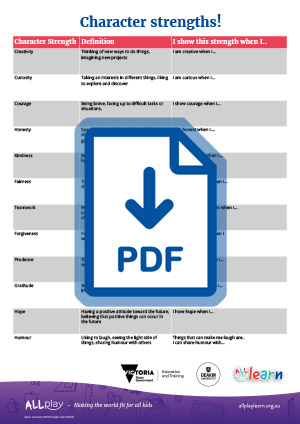
Physical Disability
On this page:

About physical disability
Physical disability is a term used to describe any lifelong condition that affects a person’s ability to move, or to control their body movements. Students with physical disabilities will differ in how much their movement is impacted as there are many different types and causes. This includes paralysis (inability to move one or more limbs), problems with muscle tone, reduced balance, reduced ability to make larger or gross motor movements (e.g. challenges with walking and running), and reduced ability to make smaller or more precise movements (e.g. challenges with writing and doing up shoe laces). Common causes of physical disability include acquired brain injury (e.g. after a stroke), spinal cord injury, cerebral palsy, spina bifida, loss of limbs and muscular dystrophy.
Some students with physical disability will walk independently, while others will use mobility aids (e.g. ankle supports, crutches or wheelchairs). Some students may need support with completing everyday tasks by themselves. They may need extra time to learn and practise new skills.

Strengths
What might be some strengths?
- Young people with physical disabilities have different strengths depending on how they might be affected by the condition.
- Some may have typical language and thinking skills and can learn like any other student.
- Some students with physical disabilities have great self-determination skills - they are able to set goals, and work hard to achieve them.
- Some students are strong visual learners and are able to process and maintain visual information.
Where might you provide support?
- Some students with physical disabilities may need support with movement, coordination and balance. Some students might use mobility aids such as a walking frame or a wheelchair.
- Students with physical disabilities may experience chronic or recurring pain. This may affect their behaviour. They may become less motivated to engage in school activities.
- Some students with physical disabilities have difficulty with social situations, as well as with forming and maintaining peer relationships.
- Some students may experience challenges with staying focussed on tasks and discussions in the classroom.
- Some students may have difficulties with writing tasks.

Evidence-based strategies
Consider adjustments to teaching style
Tailor activities to be as inclusive as possible
Consider adjustments to communication style
- Allow more time to learn skills and understand concepts. Some students may need extra time to process and learn new skills in the classroom. It may be helpful to break down key learning concepts and activities into smaller but challenging sequences. Students may need to master basic concepts before moving onto more complex ones.
- Provide accessible materials. Provide a range of book formats, such as large print or audio versions, and make sure that all learning resources are within reach.
- Provide access to breaks and rest. Provide breaks and a space for rest for students who fatigue or need time to manage their health needs.
- Plan ahead. Consider preparing equipment or adjustments that encourage full participation of students before beginning an activity.
- Use alternative methods for assessments. Such as verbal responses instead of written, or extended time for completing tasks.
- Use clear and accessible communication methods. For example, if a student has difficulty with verbal communication, use visuals or alternative communication devices.

Best practice tips
Focus on what students can do
Consider seating position and duration
Consider whether the physical space needs to be rearranged
Promote independence
Engage the student in decision making
Encourage full participation
Allow plenty of time for transitions
Consider the height and accessibility of locker spaces for a student
Promote self-determination
- Identify student strengths and positive efforts and provide encouragement. This can make a difference in student participation, learning, and interactions with other students.
- Some students might need extra help to support their posture. This may help with pain management, as well as with classroom tasks such as handwriting. Bean bags or pillows may help. Talk to the student, and other professionals that support the student, to identify the best seating position for the student.
- Check that pathways are free, wide enough, and neat so that student can move easily and without risk of injury. If a table is used, check that it has plenty of room underneath it for the student to sit comfortably and participate.
- When possible, allow the student to choose what they would like to do (e.g. during lunchtime). Encourage staff to give students space to explore or learn independently or with other students. This will help to encourage social interactions with peers.
- In addition to collaboration with parents and health professionals, provide opportunities for the student to participate when making decisions about their learning needs and goals.
- Consider how students with physical disabilities can be actively included in activities rather than only watching or listening. This will allow them to develop friendships, learn from other students and develop shared understandings of new skills and behaviours. Role playing or small group work may support participation.
- Some students with physical disabilities may need extra time to move between classrooms and buildings. Consider pairing the student with a peer that can assist.
- Lockers that are located on the ‘end’ may support accessibility, and similarly, lockers located near classrooms may help. Some students may need specialised locks. Collaborate with the student, their family and/or their health professionals to plan how to support locker and school grounds accessibility.
- Promote self-determination. Empower and teach students to make simple choices, set goals, be independent, and develop problem-solving abilities. Use technology as needed.

Curriculum considerations
- Promote creativity to allow self-expression. This might encourage positive behaviour, friendships and self-esteem.
- Consider adjustments to teaching style.
- Adapted materials may be needed so that a student can fully participate. For example, thicker pencils and paintbrushes might help with grip. Paper can be taped down and placed on slanted surfaces.
- Refer to AllPlay Dance for more strategies to include students in dance.
- Encourage the use of devices and objects that best support the student’s communication and learning, and that best fits their bodily needs. For example, some students might learn better with pictures cards that are used along with verbal instruction, whilst others might benefit from audiobooks or text-to-speech technology.
- Encourage active participation in literacy activities. A variety of methods (e.g. reading, drawing, videos) may engage and motivate students.
- For students who need support with movement, coordination, and balance, physical education will need adjustments.
- Encourage team work and give the student an active role in sporting activities. This will provide opportunities for the student to participate and give them a sense of belonging and acceptance.
- Encourage a culture of respect among students. Consider including videos that highlight the participation and strengths of role models with physical disabilities.
- Consider the student's strengths and use this to guide physical activities. Some rules during sporting games may need to be changed to encourage full participation. For example, instead of kicking a ball, a student could carry the ball instead. Similarly, a delayed defence rule, where students can choose three, five or 10 seconds of delay before a defender can approach them in a game, may be helpful for some students.
- Consider what accommodations could be made to sporting equipment. For example, lighter balls, bats or racquets may benefit students with physical disabilities. Lower basketball nets may be helpful for students who sit in a wheelchair.
- Check that the surface of the sporting area is not too slippery or sticky for the student to move around.
- Be aware of signs of pain and fatigue. Look for non-verbal signs such as changes to facial expressions, changes in movement, changes in behaviour, and changes in peer interactions.
- Some students may need frequent rest breaks to manage fatigue and pain.
- Refer to AllPlay Footy to find more resources for sport/football
- Refer to AllPlay Dance to find more resources for dance
- Refer: Consider adjustments to teaching style
- Using different approaches to learning, such as adding visual aids (e.g. picture cards; captioned videos) to verbal instructions, may be helpful
- If a student uses adaptive technology to assist with everyday tasks, consider using these in the maths classroom. For example, if a student uses a laptop with an adapted keyboard, include maths exercises that are available in an online format for the student.
- Computer software may help students learn and practise numeracy skills
- Consider the learning environment to allow safe learning for students with physical disability. For example, check that pathways are wide enough for easy accessibility.
- Consider the equipment. For example, check that the tables are at an appropriate height for those that sit on a wheelchair and that items such as microscopes can be easily reached by the student.
- It may help to pair students with a lab partner to encourage full participation in hands-on activities. Consider choosing different partners across the term so that a young person can develop a range of friendships with other students.
- Check that tables have enough space underneath so that students (i.e. those in wheelchairs) can sit comfortably. Consider seating position and duration for students who need extra help to support their posture.
- Some students might benefit from computer software or modified keyboards, to enhance participation and communication in the classroom. Work collaboratively with the student’s health professionals (e.g. an occupational therapist).

Other considerations
First aid
Safety drills
Behaviour
Homework or assessments
Excursions
Self-management
Transitions
Other co-occurring conditions
- Talk to the student’s caregivers about ways to manage injury, illness, pain and fatigue early on.
- Build a relationship with other professionals that look after the student (e.g. occupational therapist). That way you will be informed on signs to look for, adjustments that can be made to relieve discomfort, and the best ways to manage injury, illness, pain and fatigue. Frequent check-ins may be needed with some students.
- Some students with physical disability may not know how to tell an adult if there is an emergency, or what to do in an emergency or emergency drill. Consider making time to demonstrate and practise.
- Develop and practise emergency evacuation plans that account for the needs of students with physical disabilities, ensuring they are safe and can exit the classroom effectively in case of an emergency.
- Some students might show challenging behaviours. It’s important to remember children are most likely trying to communicate a need or want that is not being met.
- Students can monitor their performance if they have a clear understanding of what is expected. Consider talking with students to check their understanding of expectations.
- Refer to the ABC approach for more information on how to reduce challenging behaviour by supporting the young person and promoting more helpful behaviour, and our emotions page for more information about supporting a young person with managing their emotions.
- Some students with physical disabilities may find completing homework and other assessment tasks challenging. Consider the student’s use of technology or assistive devices. For example, some students might have trouble with writing and may benefit from homework that they can complete using their assistive computers/keyboards.
- Consider allowing students to take tests orally, rather than in writing, or providing a scribe or reader.
- Some students may need extra time to complete assessment tasks.
- Consider the transportation needs of the student. For example, if using a bus, check that it has ramps and is wide enough to accommodate a wheelchair or other mobility aids. Consider the destination and whether it is accessible and safe for the student.
- Some students may need to take frequent breaks during the excursion.
- Discuss with a student’s family or other professionals any additional strategies or equipment (e.g. adapted toilet seat, step ladder, railings) that can be used at school to support the student.
- Students with physical disabilities may benefit from being able to choose when and how they might need extra help. Talk to the student to determine the best approach to help seeking, as 'too much' help may decrease self-esteem and limit the student’s sense of belonging.
- For more information about supporting students with disabilities when transitioning across education settings, access AllPlay Learn's transition page.
- Post-school transition to adult life should begin as early as possible in school.
- Aim to increase independence by working on organisational, social and problem-solving skills, and time- and self- management skills. Provide plenty of opportunities to practise them across a range of contexts.
- It may be helpful to identify skill gaps and develop a support plan to help them be successful (e.g. social skills, academic and/or employment skills).
- Physical disabilities can often co-occur with other developmental challenges such as intellectual disability or specific learning disability. They can also co-occur in teenagers who experience Deaf, deaf and hard of hearing, blind or low vision, and challenges with attention and communication challenges.
- Refer to information about these areas to help support the student

Relevant resources
Visit our resources page for a range of resources that can help to create inclusive education environments for students with disabilities and developmental challenges. Some particularly relevant resources for students with physical disability include:



